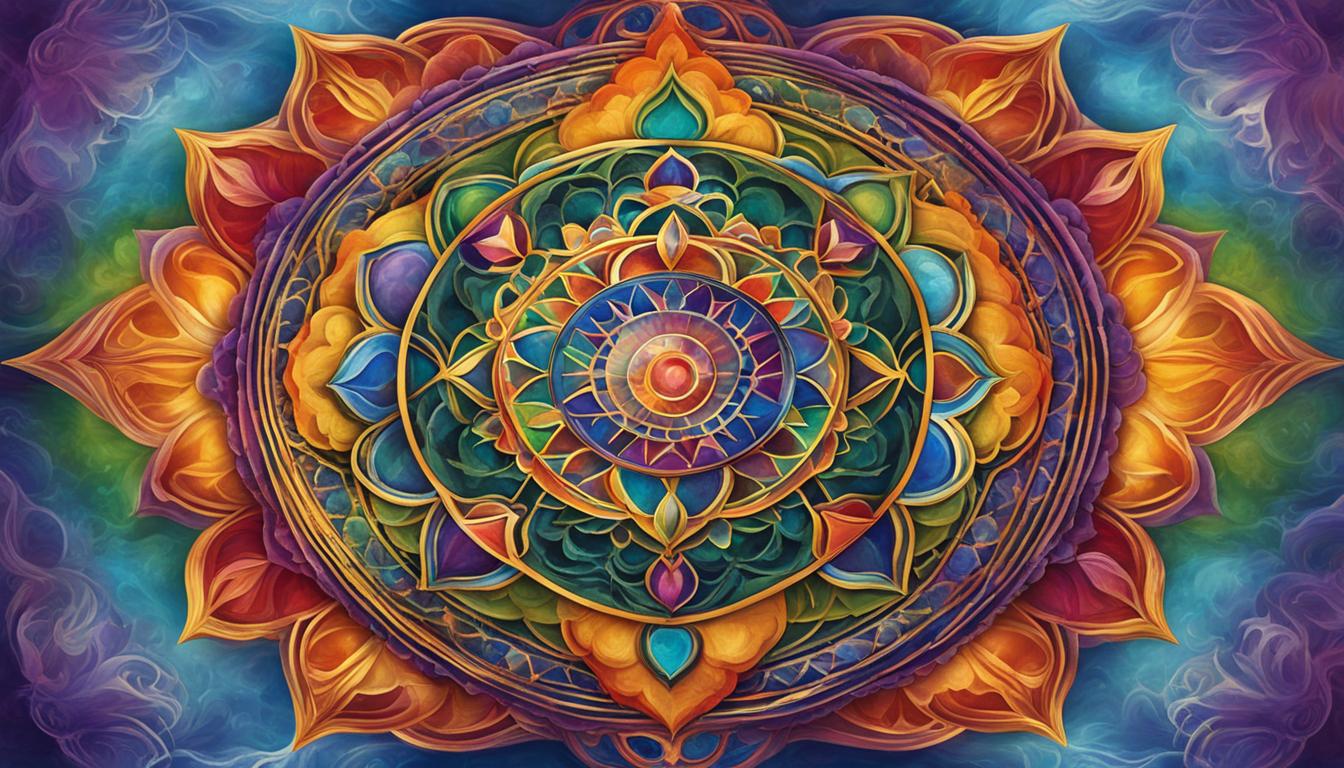Welcome to our comprehensive guide on understanding chakras. In this article, we will explore the fascinating world of chakra energy centers and delve into the intricacies of the chakra system. Chakras, located along the spine, play a vital role in our overall well-being and health. By gaining a deeper understanding of these energy centers and learning how to balance them, we can enhance our spiritual, emotional, psychological, and physical aspects of being.
Key Takeaways:
- Chakras are energy centers located along the spine.
- They correspond to different aspects of our being.
- Understanding and balancing chakras contribute to overall well-being.
- There are seven main chakras in the body.
- Imbalances in chakras can lead to various disorders.
What are Chakras and How Many Chakras are in the Body?
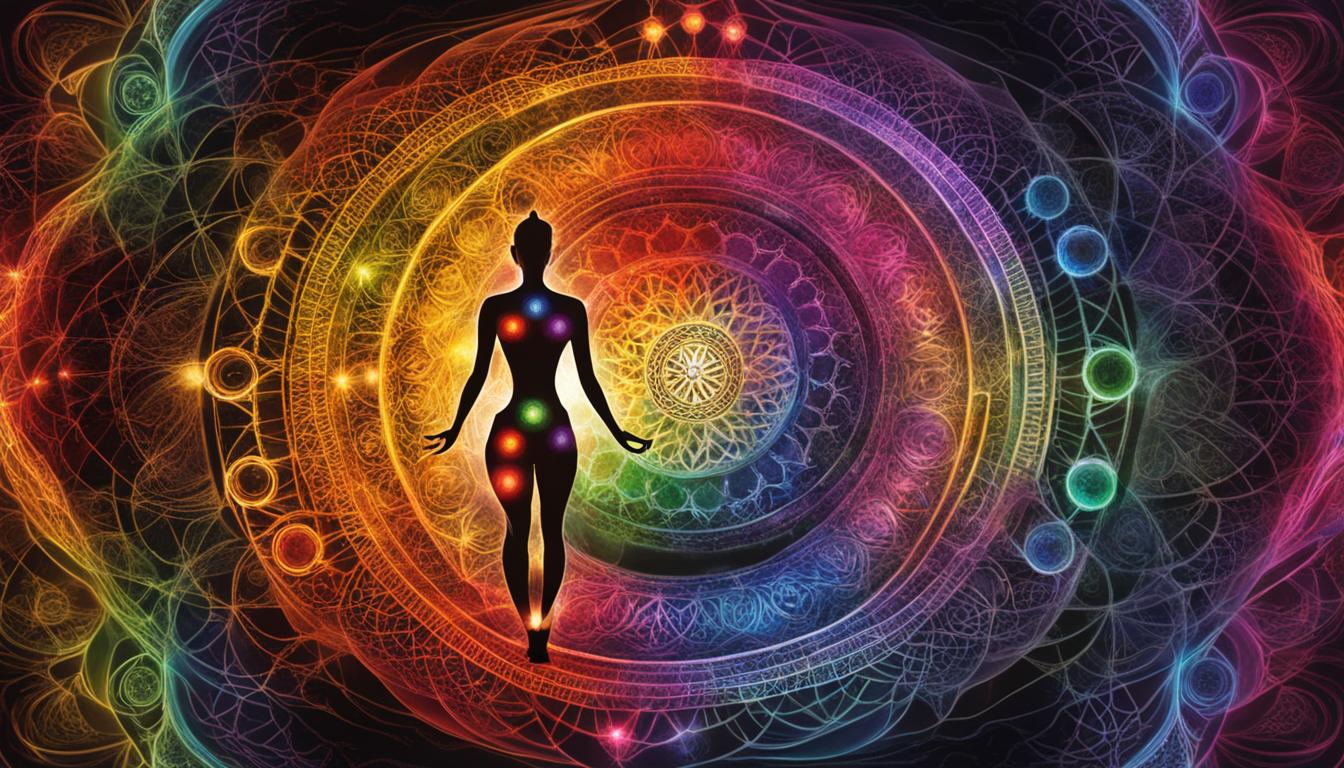
Chakras are the energy centers located in the astral body along the spine. They are an integral part of various spiritual and healing practices, and understanding their significance is crucial for holistic well-being. But what exactly are chakras, and how many are there in the body?
Chakras can be described as spinning wheels of energy that correspond to different aspects of our being. While there are believed to be an infinite number of chakras in the human body, the main focus is on the seven major chakras. These seven chakras are known as the Muladhara Chakra, Svadhishthana Chakra, Manipura Chakra, Anahata Chakra, Vishuddha Chakra, Ajna Chakra, and Sahastrara Chakra. Each chakra is associated with specific attributes, colors, symbols, and sounds.
The chakra system is a complex and interconnected network, with each chakra serving a unique purpose. Understanding and balancing these chakras is believed to enhance our spiritual, emotional, psychological, and physical well-being. By working on these energy centers, we can achieve a greater sense of harmony and alignment within ourselves.
The Shape and Size of Chakras
The shape and size of chakras have been the subject of much speculation and interpretation. According to ancient scriptures, chakras are often described as spherical or ball-like in shape. However, there are various beliefs and visualizations about the shape of chakras, including depictions of whirling discs, flowers hanging from the spine, and even ice cream cones.
While the shape of chakras may be open to interpretation, their size can also vary. Some practitioners believe that chakras are approximately one foot in radius, while others suggest that their size can change depending on the flow of energy within the body. Regardless of their actual size, it is important to note that chakras are located within the astral spinal cord, which exists within the physical spinal cord.
Overall, understanding the shape and size of chakras can help us visualize and connect with these energy centers. Whether we perceive them as spheres or discs, it is the balance and flow of energy through these chakras that is considered crucial for our overall well-being and spiritual growth.
The 7 Chakras: Symbols, Symptoms, and Effects
The human body is a complex system of energy centers known as chakras. These chakras play a crucial role in our physical, emotional, and spiritual well-being. Understanding the seven main chakras, their symbols, and the effects they have on our lives can help us achieve balance and harmony.
Muladhara Chakra (Root Chakra)

The Muladhara Chakra, also known as the Root Chakra, is located at the base of the spine. It represents our connection to the physical world and governs our sense of stability, security, and survival. When the Root Chakra is balanced, we feel grounded, secure, and confident. However, imbalances in this chakra can lead to feelings of fear, insecurity, and instability.
Svadhishthana Chakra (Sacral Chakra)
The Svadhishthana Chakra, or Sacral Chakra, is located in the lower abdomen. It is associated with our emotions, creativity, and sexuality. When this chakra is balanced, we experience emotional well-being, abundant creativity, and healthy sexual energy. Imbalances in the Sacral Chakra can manifest as emotional instability, lack of creativity, and sexual dysfunction.
Manipura Chakra (Solar Plexus Chakra)
The Manipura Chakra, also known as the Solar Plexus Chakra, is located in the upper abdomen. It is associated with our personal power, confidence, and identity. When this chakra is balanced, we have a strong sense of self, assertiveness, and inner strength. Imbalances in the Solar Plexus Chakra can result in low self-esteem, digestive issues, and a lack of confidence.
Anahata Chakra (Heart Chakra)
The Anahata Chakra, or Heart Chakra, is located in the center of the chest. It governs our capacity to give and receive love, compassion, and forgiveness. When this chakra is balanced, we experience deep connections with others, empathy, and unconditional love. Imbalances in the Heart Chakra can lead to emotional pain, anger, and a lack of trust in relationships.
Vishuddha Chakra (Throat Chakra)
The Vishuddha Chakra, or Throat Chakra, is located in the throat area. It is associated with communication, self-expression, and our ability to speak our truth. When this chakra is balanced, we have clear and authentic communication skills and are able to express ourselves creatively. Imbalances in the Throat Chakra can result in difficulties in communication, fear of speaking up, and creative blocks.
Ajna Chakra (Third Eye Chakra)
The Ajna Chakra, or Third Eye Chakra, is located between the eyebrows. It is associated with intuition, insight, and higher consciousness. When this chakra is balanced, we have a clear and expanded perception of reality, enhanced intuition, and a strong connection to our inner wisdom. Imbalances in the Third Eye Chakra can manifest as lack of clarity, confusion, and difficulty making decisions.
Sahastrara Chakra (Crown Chakra)
The Sahastrara Chakra, or Crown Chakra, is located at the top of the head. It represents our spiritual connection and access to higher consciousness. When this chakra is balanced, we experience a deep sense of inner peace, spiritual awareness, and a connection to the divine. Imbalances in the Crown Chakra can result in feelings of disconnection, spiritual emptiness, and lack of purpose.
By understanding the symbols, symptoms, and effects of the seven main chakras, we can identify imbalances and work towards restoring harmony and balance in our energy centers. Through practices like meditation, yoga, and energy healing, we can connect with the power of our chakras and experience optimal well-being in all areas of our lives.
Balancing the Root Chakra: Muladhara Chakra
The Root Chakra, also known as the Muladhara Chakra, is the first of the seven main chakras in the body. Located at the base of the spine, it is associated with the color red and the element earth. The Root Chakra is responsible for grounding and connecting us to the physical world.
A blocked Root Chakra can manifest in various symptoms, including feelings of insecurity, lack of ambition, and a sense of instability. It can also impact our physical well-being, causing issues such as lower back pain and digestive problems. Recognizing these symptoms is crucial in identifying and addressing any imbalances in this energy center.
Fortunately, there are signs that indicate a balanced Root Chakra. When this chakra is functioning harmoniously, we experience a sense of security, stability, and a strong connection to our physical body and the world around us. We feel grounded, motivated, and confident in our abilities. Maintaining a balanced Root Chakra contributes to overall well-being and helps us navigate life with a solid foundation.
To balance the Root Chakra, there are various techniques one can practice. Yoga poses such as Tree Pose and Mountain Pose help to ground and stabilize this energy center. Chanting the seed mantra “Lam” can also be beneficial in stimulating and harmonizing the Root Chakra. By incorporating these practices into our daily routine, we can work towards achieving a balanced and healthy Muladhara Chakra.
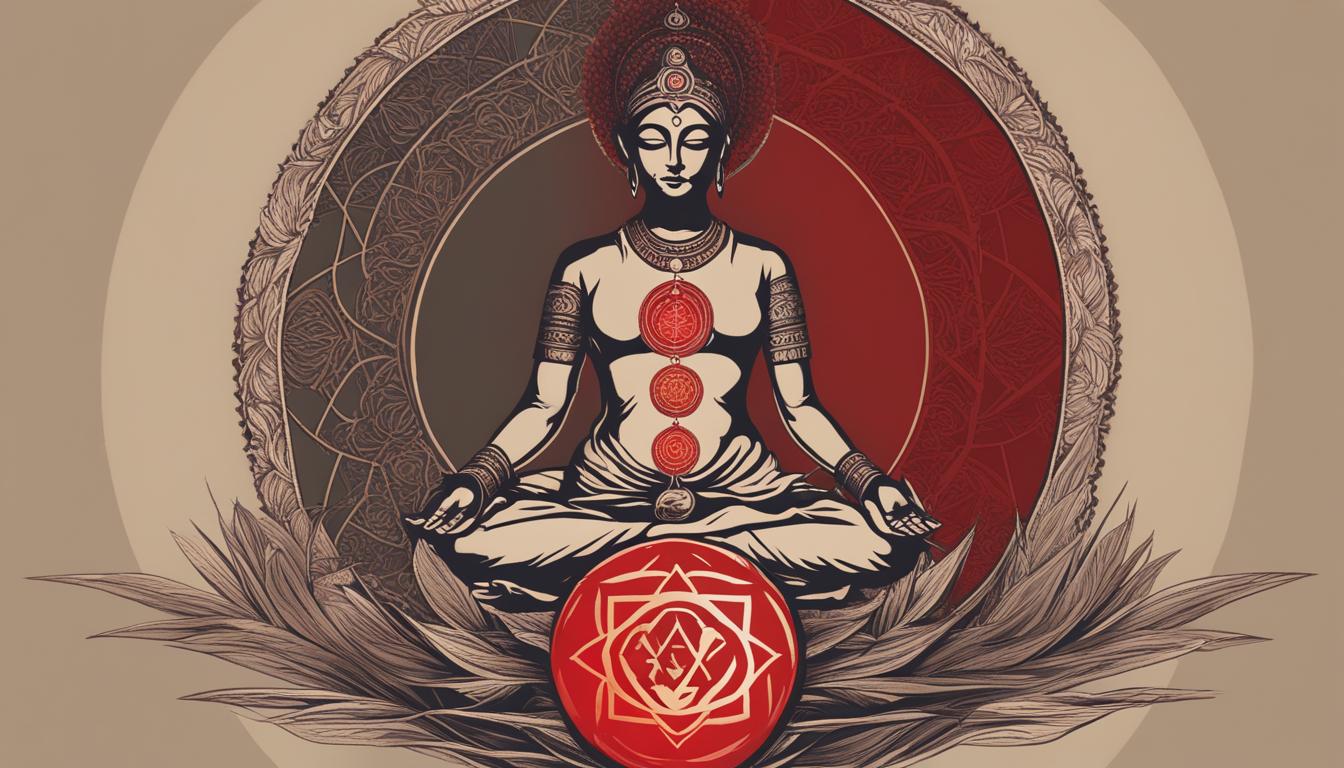
Signs of a Balanced Root Chakra:
- Feeling grounded and connected to the physical world
- A sense of stability and security
- Having a strong sense of ambition and drive
- Feeling safe and secure in one’s environment
Symptoms of a Blocked Root Chakra:
- Feelings of insecurity and instability
- Lack of ambition or motivation
- Experiencing financial difficulties
- Physical issues such as lower back pain or digestive problems
“Balancing the Root Chakra is essential for establishing a solid foundation for our overall well-being and sense of security in the world.”
Activating the Sacral Chakra: Svadhishthana Chakra
The Sacral Chakra, also known as the Svadhishthana Chakra, is an important energy center associated with emotions, sexuality, and creativity. Activating and balancing this chakra is crucial for experiencing a harmonious and fulfilling life. By understanding the symptoms of a blocked Sacral Chakra and recognizing the signs of a balanced one, you can take steps towards activating and restoring the energy flow in this vital chakra.
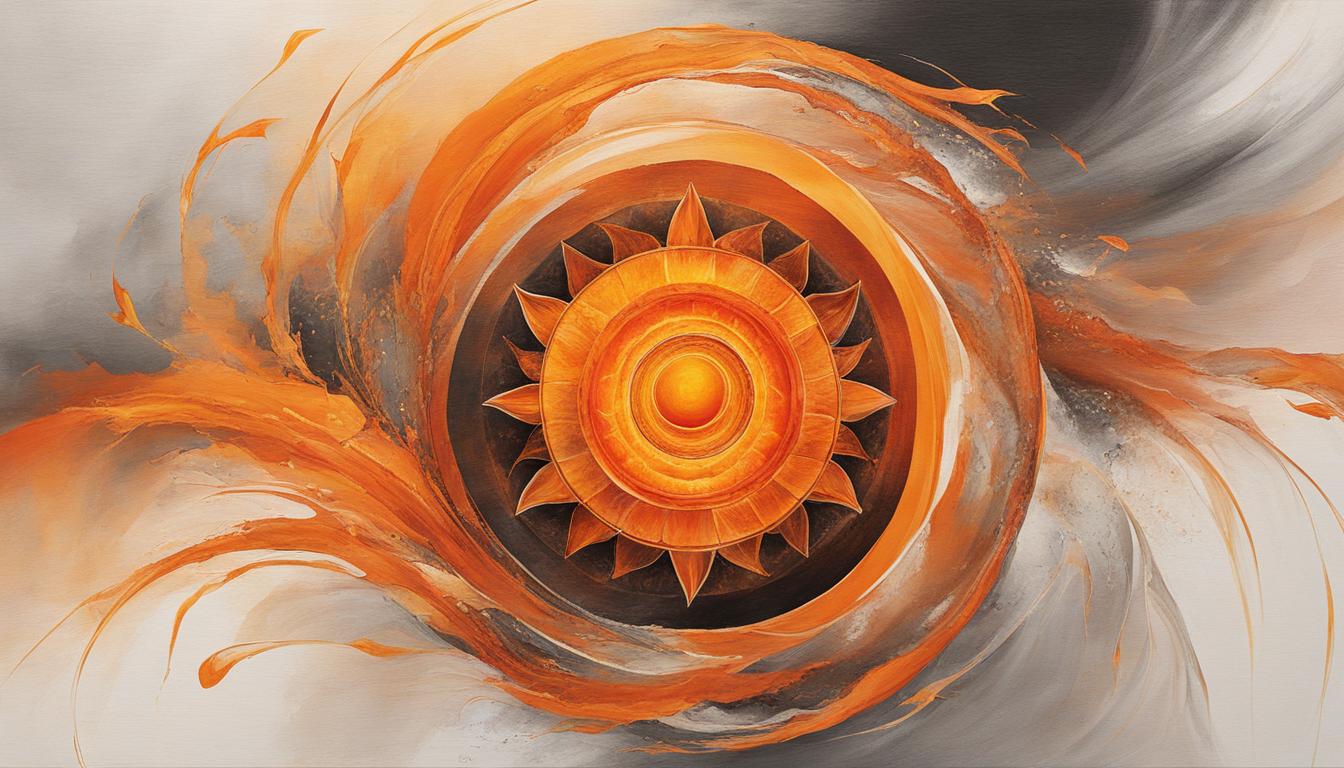
When the Sacral Chakra is blocked, you may experience a variety of symptoms, including a lack of passion or enthusiasm, emotional instability, and difficulty expressing your creativity. You may feel disconnected from your sensuality or struggle with intimacy and relationships. These blockages can manifest in physical symptoms such as lower back pain, menstrual issues, or urinary problems.
To activate and balance the Sacral Chakra, there are several practices you can incorporate into your daily routine. Engaging in activities that inspire your creativity, such as painting, dancing, or writing, can help stimulate this chakra. Yoga poses that target the lower abdomen, such as the Bound Angle Pose (Baddha Konasana) or the Pigeon Pose (Eka Pada Rajakapotasana), can also be beneficial.
Mantra for Svadhishthana Chakra:
“Vam”
Chanting the seed mantra “Vam” while focusing on the Sacral Chakra can help activate and unlock its energy. Find a quiet and comfortable space, close your eyes, and repeat the mantra aloud or silently. Visualize a bright orange light radiating from the area of your lower abdomen, revitalizing and balancing your Sacral Chakra.
Balancing the Solar Plexus Chakra: Manipura Chakra
The Solar Plexus Chakra, also known as the Manipura Chakra, is one of the seven main chakras in the body. Located in the upper abdomen, it is associated with personal power, self-confidence, and identity. When the Solar Plexus Chakra is balanced, it empowers us to take control of our lives and make confident decisions.
Symptoms of a blocked Solar Plexus Chakra may include feelings of insecurity, low self-esteem, and a lack of direction or purpose. Physical signs can manifest as digestive issues and poor metabolism. To balance the Solar Plexus Chakra, it’s important to release any negative emotions, gain clarity about your goals, and develop a strong sense of self.
A mantra that can be chanted to activate and balance the Solar Plexus Chakra is “Ram.” Chanting this sound helps stimulate the energy flow in the chakra and strengthens its influence on our personal power and confidence. Yoga poses that are beneficial for balancing the Solar Plexus Chakra include Classical Forward Bend and Bow Pose, as they activate the abdominal area and stimulate the chakra’s energy.
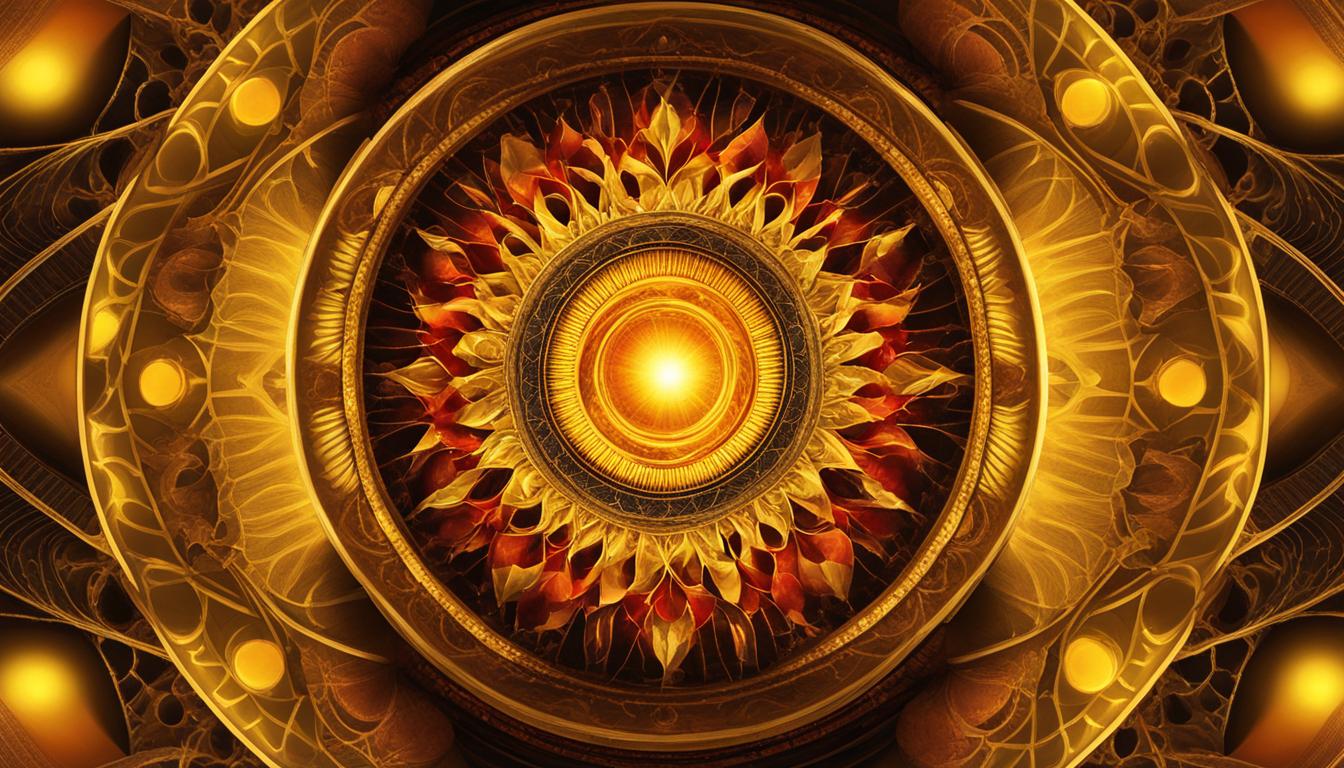
Signs of a Balanced Solar Plexus Chakra:
- Increased self-confidence and self-worth
- Enhanced decision-making abilities
- Improved metabolism and digestive health
- Greater sense of personal power and empowerment
“When the Solar Plexus Chakra is balanced, you feel a strong sense of self and have the confidence to pursue your goals with determination and clarity.”
Balancing the Solar Plexus Chakra is essential for cultivating a healthy sense of self and embracing your personal power. By practicing chakra healing techniques such as chanting, yoga poses, and meditation, you can restore balance to this energy center and experience the positive effects it has on your overall well-being.
Opening the Heart Chakra: Anahata Chakra
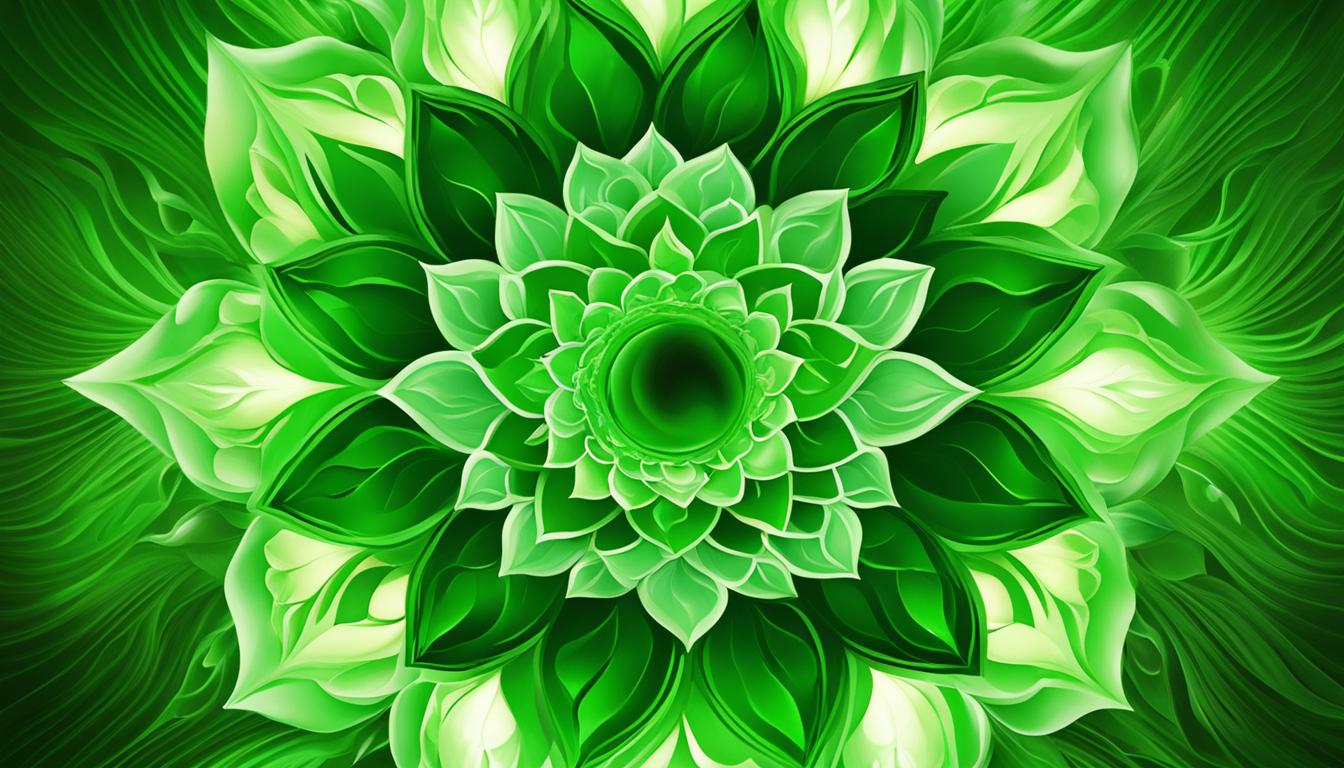
The Heart Chakra, also known as the Anahata Chakra, is a vital energy center located in the center of the chest. It is associated with the color green and the element of air. The Heart Chakra is responsible for our capacity to love, feel compassion, and form harmonious relationships with ourselves and others. When the Heart Chakra is blocked or imbalanced, it can lead to emotional issues such as anger, resentment, and lack of trust.
Signs of a balanced Heart Chakra include the ability to give and receive love unconditionally, feeling a deep sense of compassion towards oneself and others, and experiencing meaningful and nurturing relationships. It is essential to maintain an open and balanced Heart Chakra to foster emotional well-being, personal growth, and healthy connections with those around us.
To open and balance the Heart Chakra, there are various practices you can incorporate into your daily routine. Yoga poses that specifically target the Heart Chakra, such as Camel Pose and Bridge Pose, can help stimulate energy flow in this area. Meditation focused on love and compassion can also be beneficial. You can use the seed mantra “Yam” during meditation to enhance the activation of the Heart Chakra.
Symptoms of a blocked Heart Chakra:
- Feeling emotionally closed off or disconnected from others
- Difficulty forming or maintaining meaningful relationships
- Experiencing feelings of anger, resentment, or bitterness
- Lack of empathy or compassion towards oneself and others
- Feeling unworthy of love or struggling to love oneself
Signs of a balanced Heart Chakra:
- Feeling a deep sense of love and compassion towards oneself and others
- Having fulfilling and nurturing relationships
- Experiencing emotional healing and forgiveness
- Feeling connected to the world around you
- Being able to give and receive love unconditionally
“The heart chakra is the center of our emotional well-being and our ability to connect with others. When balanced, it allows for the free flow of love and compassion, creating a sense of harmony and unity within ourselves and the world.”
Conclusion
Understanding and balancing the chakras is essential for overall well-being and optimal health. By incorporating chakra balancing techniques into your daily routine, such as yoga poses, meditation practices, and chanting mantras, you can stimulate and harmonize the energy centers in your body.
Chakra meditation practices allow you to focus your attention on each energy center, promoting balance and healing. Through mindful breathing and visualization, you can release any blockages and restore the flow of energy within your chakras.
Chakra healing techniques, including crystal therapy, sound healing, and aromatherapy, can also be beneficial in clearing and opening your chakras. These modalities work in conjunction with your body’s natural energy system to promote deep healing and restore balance.
If you experience chakra blockages, such as physical ailments, emotional imbalances, or a sense of disconnect, it’s important to seek remedies. Working with a holistic practitioner or energy healer can provide insight and guidance in identifying and addressing any chakra imbalances you may have.
FAQ
What are chakras?
Chakras are the energy centers of the body that are located along the spine. They correspond to specific aspects of our being, including spiritual, emotional, psychological, and physical.
How many chakras are there in the body?
While there are an infinite number of chakras in the human body, the main focus is on the seven chakras. These include the Muladhara Chakra, Svadhishthana Chakra, Manipura Chakra, Anahata Chakra, Vishuddha Chakra, Ajna Chakra, and Sahastrara Chakra.
What is the shape of a chakra?
The shape of a chakra is often described as a sphere or a ball, according to ancient scriptures. However, there are various beliefs about the shape of chakras, including whirling discs, flowers hanging from the spine, and even ice cream cones.
What is the size of a chakra?
The size of chakras can vary. Some people believe they are one foot in radius, while others say they change size based on energy flow. The chakras are located in the astral spinal cord, which is inside the physical spinal cord.
What is the Muladhara Chakra?
The Muladhara Chakra, also known as the Root Chakra, is associated with the color red and the element earth. It is located at the base of the spine and is connected to survival, stability, and ambition.
How can I balance the Root Chakra?
Balancing techniques for the Root Chakra include yoga poses like Tree Pose and Mountain Pose, as well as chanting the seed mantra “Lam.”
What is the Svadhishthana Chakra?
The Svadhishthana Chakra, also known as the Sacral Chakra, is associated with the color orange and the element water. It is located in the lower abdomen and is connected to emotions, sexuality, and creativity.
How can I activate the Sacral Chakra?
Balancing techniques for the Sacral Chakra include yoga poses like Crow Pose and Triangle Pose, as well as chanting the seed mantra “Vam.”
What is the Manipura Chakra?
The Manipura Chakra, also known as the Solar Plexus Chakra, is associated with the color yellow and the element fire. It is located in the upper abdomen and is connected to personal power and identity.
How can I balance the Solar Plexus Chakra?
Balancing techniques for the Solar Plexus Chakra include yoga poses like Classical Forward Bend and Bow Pose, as well as chanting the seed mantra “Ram.”
What is the Anahata Chakra?
The Anahata Chakra, also known as the Heart Chakra, is associated with the color green and the element air. It is located in the center of the chest and is connected to love, compassion, and harmonious relationships.
How can I open the Heart Chakra?
Balancing techniques for the Heart Chakra include yoga poses like Half Bridge Pose and Fish Pose, as well as chanting the seed mantra “Yam.”
Why is understanding and balancing chakras important?
Understanding and balancing the chakras is a key aspect of overall well-being and optimal health. Practicing chakra balancing techniques can stimulate and balance the energy centers in the body, promoting physical, emotional, and psychological healing.

